Store
Hours
|
|
Now that it's Autumn again, please
note that Kitchen Affairs
is now open on Sunday afternoons from 1:00pm - 5:00pm. Stop
in!
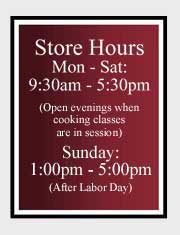 |
KA on
WTTV
|
| Just in case
you missed our latest TV segments on Ch. 7/WTVW, you
can still access the recipes at our website.
|
Bring a
Bag
|
BRING A
BAG,
SAVE A TREE,
FEED A FAMILY!
Over $400
raised so far!
Each time you make a
purchase and don't need a bag, or provide your own, we will donate
ten cents to the Tri-State Food Bank. If you don't need a bag, watch
us drop a dime in the jar on the counter. We thank you, and the
Tri-State's neediest families thank you, too.
ALL DONATIONS IN OUR JAR
WILL GO TO THE TRI-STATE FOOD
BANK! |
Mike's
Page
|
| Those who know
me, know that I enjoy musing and writing a bit. View "Mike's Page" at our
website. Read
more. | |
|
Morning
Therapy
|
Some
mornings it's the only thing that entices us out of bed - the
anticipation of that first great cup of coffee! The total experience
begins with a good dose of aromatherapy, the fragrance of the beans
as they're scooped from their container into the grinder. Then it's
the vibration of the grinder as it transforms the beans to their
brew-ready stage. Next, the sound of water pouring continues to wake
our senses. The second dose of aromatherapy floods the room as the
brew is formed and the perfume released. Finally, it's time for the
first sip - almost always followed by an "ahhh...." It's going to be
a good day! In this issue, we indulge our passion for coffee by
exploring just what it takes to make a good cup of joe - the bean,
the grind, the water, and the brewing. And what goes better with
coffee than just a little bit of sweet? We offer three recipes from
a charming cookbook, Bite-Size
Desserts, that will complement your coffee encounters in a
most delightful way!
|
NEW! Fall Class Schedule
Launches!
|
It's an
exciting season ahead in our kitchen! We think you'll have a
hard time deciding which classes to take! On the new schedule
you'll find guest chefs, seasonal topics, and classes that will
expand your skill and enjoyment of your own kitchen! Whatever your
cooking interest, there's mst likely a class for you! Check out our
website to see the
entire Class Schedule and
complete class descriptions.
Click
on the class title for full information!
Call us at (812)
474-1131, or stop in the store to register!
 Thursday,
Sept. 24 - 6:30 pm -
Simple Pasta Thursday,
Sept. 24 - 6:30 pm -
Simple Pasta
with David Pampuch.
$42
Saturday,
Sept. 26 - 9:30 am -
European Fancy Cookies
with Cathy Webb.
$40
Wednesday, Sept. 30 -
6:30 pm - Special, Animal Benefit
Class: Deep Fried Turkey with Nicki Leathem. $55.
Saturday, Oct. 3 - 9:30 am - Traditional Cast Iron
Cooking with Shelly Sackett. $40.
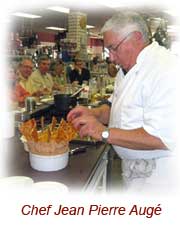 Monday,
Oct. 5 - 6:30 pm - CELEBRITY CHEF CLASS -
Chicken Tagine with Jean Pierre Auge. $55. Monday,
Oct. 5 - 6:30 pm - CELEBRITY CHEF CLASS -
Chicken Tagine with Jean Pierre Auge. $55.
Tuesday, Oct. 6 - 6:30 pm - CELEBRITY CHEF CLASS - Lamb
Noisettes with Jean Pierre Auge. $55.
Thursday, Oct. 8 - 6:30 pm - Pizza, Family Style
with David Pampuch. $42.
Saturday, Oct. 10 - 9:30 am - Uniquely Sicilian Menu
with Aimee Blume. $45.
Check
our website, and call to
reserve a place! (812) 474-1131!
|
September
Special!
|
Experience the Swiss Diamond
difference! The patented surface is different from any other
non-stick cooking surface. Diamond crystals are combined with
nano-composites to form an extremely durable, non-stick surface.
This special is a great way to try out Swiss Diamond technology and
find your "new favorite" pan!
| |
The
Bean
|
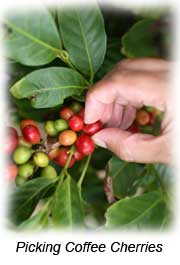 Coffee
beans are the fruit of the coffee tree, actually, more of a shrub.
They grow in the tropics in a band on either side of the equator as
seeds inside red fruit known as coffee
cherries. Each fruit contains a pair of seeds, flat sides
together. A coffee cherry with only one seed inside is known as a
"peaberry" and
is highly prized and uniquely marketed. Beans and brews are often
sold by country of origin - Sumatra, Ethiopia, Guatemala, Columbia,
etc. There are two basic types of coffee trees used for culinary
purposes, those that produce arabica beans
and those producing robusta beans.
Arabica beans are the more favored fruit and produce the better
coffees that most of us are quite fond of. Robusta beans,
easier to grow for a variety of reasons, comprise the more
mass-marketed coffees. Coffee
beans are the fruit of the coffee tree, actually, more of a shrub.
They grow in the tropics in a band on either side of the equator as
seeds inside red fruit known as coffee
cherries. Each fruit contains a pair of seeds, flat sides
together. A coffee cherry with only one seed inside is known as a
"peaberry" and
is highly prized and uniquely marketed. Beans and brews are often
sold by country of origin - Sumatra, Ethiopia, Guatemala, Columbia,
etc. There are two basic types of coffee trees used for culinary
purposes, those that produce arabica beans
and those producing robusta beans.
Arabica beans are the more favored fruit and produce the better
coffees that most of us are quite fond of. Robusta beans,
easier to grow for a variety of reasons, comprise the more
mass-marketed coffees.
Recently, coffee growing practices
have received a fair amount of attention. Agricultural systems in
the uniquely tropical coffee regions are growing rapidly to meet
global demand. Here's a glossary of a few common terms associated
with coffee bean choices:
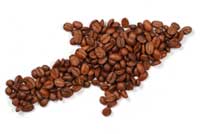 Fair Trade - Fair trade
certifications were established to provide a standard for ethical
coffee growing. Beans with the fair trade designation are grown in
working conditions that are safe and fair for the employees,
produced through environmentally sound growing practices, and where
the farmers are guaranteed a minimum price for their coffee. The
fair trade label is determined by a third-party organization that
inspects and certifies coffee growing operations. Fair Trade - Fair trade
certifications were established to provide a standard for ethical
coffee growing. Beans with the fair trade designation are grown in
working conditions that are safe and fair for the employees,
produced through environmentally sound growing practices, and where
the farmers are guaranteed a minimum price for their coffee. The
fair trade label is determined by a third-party organization that
inspects and certifies coffee growing operations.
Shade Grown - Naturally, coffee
shrubs prefer a shady location with dappled light. However, some
species can thrive in full sunlight. Shade grown coffee implies that
the forests' upper canopy have been left intact and that the
environment remains in its more natural state with minimal use of
fertilizers and mass-farming techniques. Shade grown coffee may not
produce in the quantities that full sun coffee growing conditions
might, but does not reward commercial deforestation, and, therefore,
is considered to be more friendly to the environment and protective
of wildlife habitats.
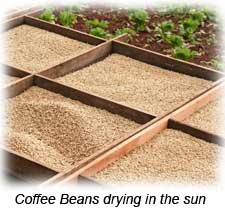 Organic
- The "organic" designation for coffee beans also defines "how" the
beans were grown - that is, without pesticides or chemical
fertilizers. The choice for organic beans reflects personal health
concerns and general environmental concerns. Organic beans are
usually more expensive due to the increased costs involved in
organic growing, certification processes, and the expense in
providing an adequate motive farmers to grow
organically. Organic
- The "organic" designation for coffee beans also defines "how" the
beans were grown - that is, without pesticides or chemical
fertilizers. The choice for organic beans reflects personal health
concerns and general environmental concerns. Organic beans are
usually more expensive due to the increased costs involved in
organic growing, certification processes, and the expense in
providing an adequate motive farmers to grow
organically.
From the tree, coffee cherries are picked as
they ripen. Finer coffee beans are picked by hand. This is due to
the variable ripening of the cherries where a look and evaluation is
required for each pluck. Cherries that are underripe, or those that
are overripe, will taint the final brew in undesirable ways.
Perfectly picked coffee cherries are then processed in one of three
ways:
Dry processing -
In this method, cherries are placed on trays and dried in full sun
for 10 - 20 days. The dried fruit pulp is removed by machine leaving
the inside seed.
Washed
processing - Through this method, the skins of the freshly
harvested cherries are removed mechanically leaving the inside pulp.
The berries are left to ferment in a tank for nearly a day, then are
washed and dried. This method is considered preferable for finer
coffees with added flavor gained from the fermentation
step.
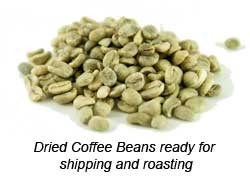 Semi-washed processing - Similar to
washed processing, just harvested berries are processed with both
skins and the pulp removed. The beans are dried with no fermentation
step involved. Semi-washed processing - Similar to
washed processing, just harvested berries are processed with both
skins and the pulp removed. The beans are dried with no fermentation
step involved.
From post-harvest processing, the beans are
readied for roasting. They are sorted and graded according to their
size, density, and color. Excellent beans are hand-sorted multiple
times. As can be seen with each of these steps, the labor intensity
of coffee is high! On to where the "green beans" go from
here!
|
The Roast and the
Grind
|
Plenty of
artistry has already gone into the coffee before it is shipped from
the farm. But the fine craft continues as the beans proceed to the
roaster. Coffee wouldn't resemble coffee if it weren't for the roast
- bitterness, smokiness, floral overtones - it all gets built into
the bean at the point of roasting. In fact, the same batch of beans
can take on completely different characteristics when roasted
differently. A coffee roaster heats the beans and moves them
constantly to promote an even roast. During the first stage of a
roast moisture is released from the bean. As heating continues,
sugars in the bean begin to caramelize. Finally, during extended
roastings, natural oils are released. The timing and temperatures of
roasting will greatly impact the flavor and determine the type of
roast moniker applied to the ready-for-market
beans:
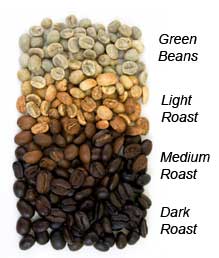 Different
Roasts: Different
Roasts:
Light roasts -
As one might guess, light roasted beans have received the least heat
and are pulled from the roaster before sugar caramelization has
occurred.
Medium roasts -
These beans have released their natural moisture and have some sugar
caramelization, but no oils unveiled.
Dark roasts -
This roast has continued longer to the point where the bean's
natural oils have been released and the bean roasted to a darker
color. Within this designation of dark roasts you'll find French,
Italian, and espresso roasts.
Coffee is best enjoyed
from freshly roasted beans. Choose your beans from purveyors that
roast or purchase in smaller quantities thereby providing turnover
and greater freshness.
|
Coffee from Kitchen
Affairs
We are pleased
to offer you freshly roasted varieties of fine
coffees. Our roasters roast in small quantities
for maximum freshness and ultimate control over
the outcome. Among our coffee selections you'll
find exquisite medium and dark roasts, flavored
coffees, and some great blends. Once you taste our
beans, we think you'll agree that it's the coffee
to drink in Evansville!
The art of
properly roasting coffee is similar to the art of
finely blending wines, or whiskeys. Done
incorrectly, freshly roasted coffee may be
inferior in taste to commercially roasted beans.
This is why we don't roast our own beans at
Kitchen Affairs. We haven't the training and
experience necessary to produce a superior-roasted
bean. Instead, we buy coffee from 4 different
commercial roasting houses, selecting only the
best products each produces.
We also sell
about a ton of coffee a year, literally! We're
pretty sure that makes us the largest seller of
whole beans in Evansville, and that means the
beans you buy from us are always fresh. If beans
sit too long in our bins, we grind them and donate
them to local charity kitchens. We don't want to
sell you stale coffee!
A NOTE
ABOUT BLENDS: We sell a few blends in the
store which are not available through our website.
This is because we blend them ourselves. Among
these are our most popular blends; our
Nashville Blend (a
flavored blend of hazelnut, vanilla and Kenya
coffees) and Mike's House
Blend (of both dark and medium roast
beans, from 4 continents). These are available in
both regular and decaffeinated versions. We also
custom blend for our customers. Stop in and talk
to Mike about creating your own "special" blend of
coffee. | | |
Grinding the
Beans:
Grind whole beans just before brewing. This allows
the nuanced flavors and volatile aromas to be retained and infused
in your coffee. The fineness of the grind is determined by how long
the coffee is in contact with the water during the brewing cycle.
Finer grinds are used for drip brewing, where a coarser grind is
suitable for French press brewing. Very fine grinds are used for
espresso brewing.
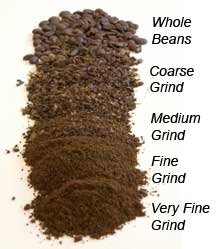 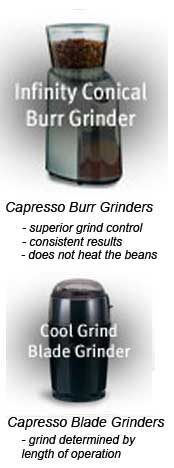 There
are many styles of coffee grinders to choose from; they generally
falling into one of two categories: There
are many styles of coffee grinders to choose from; they generally
falling into one of two categories:
Burr Grinders -
This style of coffee grinder allows the most control over the
grinding process. The beans are crushed between a moving wheel and a
stationary surface. With a burr grinder you can variously adjust the
fineness of the grind and achieve consistent results. Burr grinders
may have either a wheel or conical style of grinding mechanism.
Conical burr grinders are considered preferable, especially for
darker, oilier roasts which may clog other
grinders.
Blade Grinders
- Also called "impact" grinders, these machines use a metal blade to
crush the beans. The fineness of the grind is governed by the length
of operation, a potentially imprecise science. Impact grinders will
also produce less consistency in the evenness of the grind.
When choosing a grinder, evaluate how it operates,
durability of its motor, the heat generated (avoid burnt grounds),
its capacity, and on/off safety mechanisms. Match your need for
different grinds with the grinders' capabilities. Check Capresso's Features
Chart.
|
The
Brew
|
No pressure,
but now the artistry of the final product is all on you! You've
chosen the right bean, accomplished the right grind, it's time to
brew.
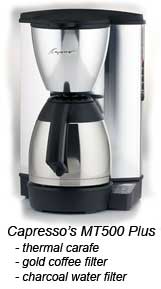 Water
- Coffee is mostly water, so this is a critical step. Use freshly
filtered water that has had any chlorine removed. Many simple water
filtering systems are available that will yield great water for
coffee and for general consumption. Do not use distilled water as it
has no character. Softened water has too many minerals added and can
prove to have a distracting taste. Water
- Coffee is mostly water, so this is a critical step. Use freshly
filtered water that has had any chlorine removed. Many simple water
filtering systems are available that will yield great water for
coffee and for general consumption. Do not use distilled water as it
has no character. Softened water has too many minerals added and can
prove to have a distracting taste.
How Much Coffee to How Much Water -
This is a subjective topic -- general guidelines call for 1-2
tablespoons of coffee grounds for every six ounces of water. From
that broad range of instruction, the ratio is governed by the type
of bean, the grind, and personal strength and taste
preferences.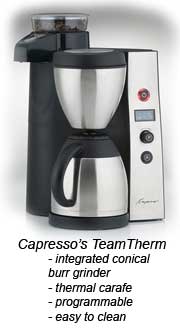
Brewing Systems: Gone are the
percolators of the olden days that produced many a pot of
questionable product. Today, brewing systems are built specifically
to brew a better cup of coffee.
Drip Brewers -
Drip brewing produces an excellent cup of coffee. Better machines
will have good mechanisms for heating the water to the perfect pitch
of 200°F.
- Consider the filtering system deployed with each machine. A
gold-filter is inert, and will not impart any taste to the coffee
as paper filtering methods might. It's essential that any
filtering mechanism be kept impeccably clean for the best tasting
pot.
- A thermal carafe will keep the coffee at the proper drinking
temperature for about an hour. Preheat a thermal carafe by filling
it with the hottest tap water available before starting the
grinder. When the coffee is ground, and the brewer is filled with
coffee and water, pour out the tap water, insert the carafe into
the brewer and turn it on!
- Timing and programmability features may be important to you;
assess their ease of use.(However, we do not recommend using a
thermal carafe in conjunction with a timer-activated brewer. The
coffee just won't be hot enough to please you. (If the brewed
coffee has to heat the insulating air between the walls of a
thermal carafe which has been sitting overnight at 68 to 72
degrees. It will reduce the temperature of the freshly brewed
coffee up to 15 degrees, enough to change "steaming-hot" to
"slightly better than luke-warm").
- Many drip brewing systems offer integrated coffee grinders -
one less step.
- Check out our insulated pump pots which will hold up to 3
liters of coffee, and keep it hot for up to 24 hours. We recommend
a separate insulated pump pot or carafe, and a glass walled carafe
in your brewer.
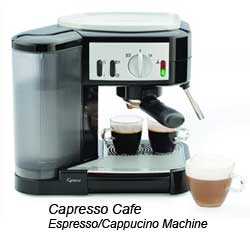 Espresso
Machines - A shot of espresso is the basis for many,
many coffee drinks. Different from brewed coffee, steam is forced
through dark-roasted, finely ground, tamped beans. Water contact
with the grounds is about 20 seconds, hence the name "espresso." The
result is an ounce of concentrated flavor savored directly or as the
basis for a latte, cappuccino, Americano, breve, or a host of other
coffee delights. Versatility is one of the primary reasons to have
your own espresso machine. Choose a machine with durability, ease of
operation, compatible level of automation, and the Espresso
Machines - A shot of espresso is the basis for many,
many coffee drinks. Different from brewed coffee, steam is forced
through dark-roasted, finely ground, tamped beans. Water contact
with the grounds is about 20 seconds, hence the name "espresso." The
result is an ounce of concentrated flavor savored directly or as the
basis for a latte, cappuccino, Americano, breve, or a host of other
coffee delights. Versatility is one of the primary reasons to have
your own espresso machine. Choose a machine with durability, ease of
operation, compatible level of automation, and the 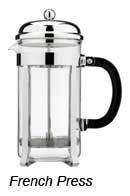 desired
accessories. desired
accessories.
French Presses
- Enjoying a recent revival, French presses are another great tool
for making a good cup of joe. Utilizing a steeping method instead of
drip brewing or forced steam, the press allows making and serving in
a single pot. French presses are available in many sizes and styles,
but all use a spring-powered method for corralling the grounds at
the bottom of the pot prior to pouring.
Enjoy your
coffee immediately after brewing! Hot plates or warming burners will
lend a burnt flavor to the coffee. Instead, keep brewed coffee in
insulated carafes.
|
Smart Coffee
Tips
|
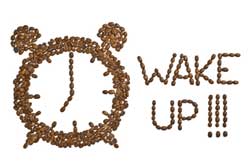 Tip
#1: Need additional help waking up and
functioning in the morning? A programmable coffee maker prepped the
night before is the best alarm clock and a kind way to face the day
with immediate gratification. Tip
#1: Need additional help waking up and
functioning in the morning? A programmable coffee maker prepped the
night before is the best alarm clock and a kind way to face the day
with immediate gratification.
Tip #2: Keep your grinder and
coffee brewer immaculately clean! Coffee grounds left in the grinder
will go stale and carryover that staleness in your next grind.
Similarly, your coffee pot must be kept exceptionally clean in order
to get the best brew. Coffee gets much of its flavor from the
volatile oils released from the beans, but it's precisely these oils
that can turn rancid and cause your next pot to be bitter and foul
tasting. A good cleaning removes any residue, and any potentially
offending oils. Clean your pot after every use and once a month brew
a cleaning solution (usually some type of citric acid) through the
system.
Tip #3:
The best coffee is made from water that is heated to 200°F. Water
boils at 212°F; the temperature should stay below that critical
point. Never allow the
brewing water or coffee to boil, nor should coffee be reheated to
the boiling point.
Tip #4: Steam or heat milk for
coffee or espresso drinks to a temperature between 150-170°F. Milk
easily gathers a scorched taste at higher temperatures than
these.
Tip #5:
Coffee isn't just for drinking, think of coffee as a flavor used to
enhance all types of dishes. Use whole beans as a garnish and finely
ground coffee as a seasoning to be incorporated into rubs, infused
into syrups, or sprinkled as a topping.
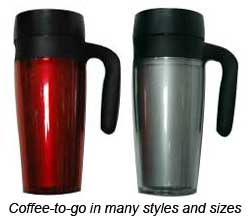 Tip #6: Like wine, coffees pair
differently with different foods. Generally, pair bold food flavors
with a bold coffee, and delicate foods with a smoother
coffee. Tip #6: Like wine, coffees pair
differently with different foods. Generally, pair bold food flavors
with a bold coffee, and delicate foods with a smoother
coffee.
Tip #7:
Add a Tablespoon of very finely ground dark roasted coffee to your
chocolate cakes or mousses, or fold it into homemade vanilla ice
cream for a true taste treat. You can even add it to your pancake or
waffle batter, and let your family try to figure out why they're so
good.
Tip
#8: Add three or four whole coffee beans to cognac,
brandy or sake before gently heating them. When you sip the drink,
you will love the enhanced
flavor.
|
Q &
A's
|
 Q: What is the cold-brewing
process for coffee? Q: What is the cold-brewing
process for coffee?
A:
Cold brewing of coffee uses medium ground coffee
steeped in a glass jar at room temperature water for 3-4 hours, or
up to overnight. The grounds are strained away and the coffee is
ready for use. Some choose to use cold brewing techniques to form a
concentrated coffee which is then blended with hot water by the cup
and produces a coffee with no acids or oils to upset the stomach. We
don't think the flavors are as robust as with a cafetiere (French
press) or drip system, but if your physician is concerned about your
coffee consumption, or if it causes you acid indigestion, this
method may be just what the Doctor should have
ordered!
Q: A
lighter roast means a weak coffee and a dark roast means a strong
coffee, right?
A: No, the strength of the
coffee, weak or strong, has to do with the ratio of coffee beans to
brewing water, and is not associated with the type of coffee
roast.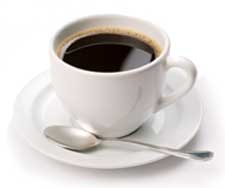
Q: Darker roasts have more caffeine
than lighter roasts, right?
A: No, wrong again! The
darker the roast, the less the caffeine. Longer roasting affects the
bean's caffeine decreasing it over time. A bold flavor does
not always equate with a bold caffeine effect.
Q: What is cupping?
A: Cupping is the process for
coffee tasting and evaluation. Using both taste and smell, the
aroma, body, acidity, flavor and finish are evaluated. Coffee
cuppings are similar in many respects to wine tasting. There are
good and bad coffees with a wide range of subjectivity throughout
the spectrum of choices.
Q: Is coffee brewed with a French
press superior to coffee brewed in a drip machine?
A: Neither method is superior
to the other, but rather, it's a matter of taste. We think there is
a place for both methods in the same kitchen. Brewing coffee for
dessert using a French press is a delightful ritual and fits the
leisurely pace found at the end of a meal. Coffee in a French press
may cool more quickly than coffee brewed into a thermal carafe.
Explore the newer double-walled French presses that address that
issue.
|
Cookbook
Review
|
Bite-Size
Desserts, Creating Mini Sweet
Treats, from Cupcakes and Cobblers to Custards and Cookies by
Carole Bloom. Copyright 2009. Published by John Wiley & Sons,
Inc., Hoboken, NJ
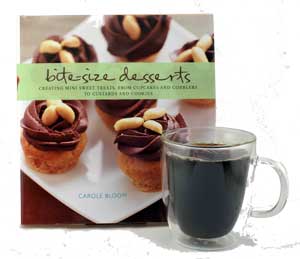 Both
the title and the cover photo compelled us to look at this book
further! We acknowledge, sometimes regrettably, that sweets are a
treat to be enjoyed in moderation, so this seemed a perfect solution
- bite-size! Ms. Bloom has assembled a treasure chest of
mini-pleasures that delight the eye, satisfy the sweet tooth, and
complement a great cup of coffee! The book honors traditional and
classic favorites only now in miniature form, and includes some new
treats that fare well in petite sizes. Cakes, muffins, tarts,
galettes, cobblers, custards, cookies and candy - they're all there
in miniature sizes. We appreciate the consistent organization of
each recipe which begins with brief author's notes, yield
quantities, an inclusive ingredient list, and very detailed
instructions. Each recipe concludes with "keeping," "streamlining,"
and "adding style" tips that further enhance the success built into
each entry. And, if the subject matter were not enough to entice us,
the photography by Glenn Cormier makes this book an artistic delight
suitable for any, well . . . coffee
table! Both
the title and the cover photo compelled us to look at this book
further! We acknowledge, sometimes regrettably, that sweets are a
treat to be enjoyed in moderation, so this seemed a perfect solution
- bite-size! Ms. Bloom has assembled a treasure chest of
mini-pleasures that delight the eye, satisfy the sweet tooth, and
complement a great cup of coffee! The book honors traditional and
classic favorites only now in miniature form, and includes some new
treats that fare well in petite sizes. Cakes, muffins, tarts,
galettes, cobblers, custards, cookies and candy - they're all there
in miniature sizes. We appreciate the consistent organization of
each recipe which begins with brief author's notes, yield
quantities, an inclusive ingredient list, and very detailed
instructions. Each recipe concludes with "keeping," "streamlining,"
and "adding style" tips that further enhance the success built into
each entry. And, if the subject matter were not enough to entice us,
the photography by Glenn Cormier makes this book an artistic delight
suitable for any, well . . . coffee
table!
|
Recipes for Sweet
Treats
|
Recipes excerpted from Bite-Size Desserts,
Creating Mini Sweet Treats, from Cupcakes and Cobblers to Custards
and Cookies by Carole Bloom. Copyright 2009. Published by
John Wiley & Sons, Inc., Hoboken, NJ. Used with permission. All
rights reserved.
Bittersweet
Chocolate and Hazelnut Tartlets
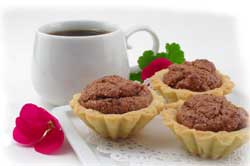 Beautiful
to look at and even better to eat, these little tartlets have a
delicate crust featuring a hint of orange zest. The filling is a
thick blend of a classic pairing -- bittersweet chocolate and
roasted hazelnuts. The assembly of these tiny tarts was accomplished
easily and the results were picture perfect and delightfully
tasting. Beautiful
to look at and even better to eat, these little tartlets have a
delicate crust featuring a hint of orange zest. The filling is a
thick blend of a classic pairing -- bittersweet chocolate and
roasted hazelnuts. The assembly of these tiny tarts was accomplished
easily and the results were picture perfect and delightfully
tasting.
Click here to view the full, illustrated
recipe.
Click here for a printable version of
the recipe.
Cinnamon-Sour
Cream Cupcakes
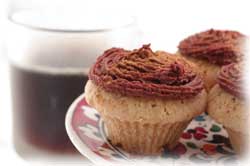 Moist
beyond belief, these diminutive cakes offered the comfort flavor of
cinnamon with just the right sweetness - reminiscent of our favorite
sour cream coffeecake. The cinnamon-flavored chocolate ganache
completed the moment. (The sturdy, small-sized silicone cups used to
bake these cupcakes were perfect in this
application). Moist
beyond belief, these diminutive cakes offered the comfort flavor of
cinnamon with just the right sweetness - reminiscent of our favorite
sour cream coffeecake. The cinnamon-flavored chocolate ganache
completed the moment. (The sturdy, small-sized silicone cups used to
bake these cupcakes were perfect in this
application).
Click here to view the full, illustrated
recipe.
Click here for a printable version of
the recipe.
Chocolate-Espresso
Pots de Crème
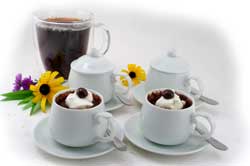 It
had been some time since we'd used our little pots de crème set.
Finding this recipe inspired us to find our special lidded cups and
experiment with this recipe. The results did not disappoint! Neither
mousse, nor custard, the chocolate-espresso flavor caused swooning
all around the table to the point of embarrassment. You'll enjoy and
be satisfied with these dainty, but potent
pleasures. It
had been some time since we'd used our little pots de crème set.
Finding this recipe inspired us to find our special lidded cups and
experiment with this recipe. The results did not disappoint! Neither
mousse, nor custard, the chocolate-espresso flavor caused swooning
all around the table to the point of embarrassment. You'll enjoy and
be satisfied with these dainty, but potent
pleasures.
Click here to view the full, illustrated
recipe.
Click here for a printable version of
the
recipe.
| |